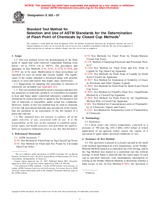Potrebujeme váš súhlas na využitie jednotlivých dát, aby sa vám okrem iného mohli ukazovať informácie týkajúce sa vašich záujmov. Súhlas udelíte kliknutím na tlačidlo „OK“.
ASTM E502-07
Standard Test Method for Selection and Use of ASTM Standards for the Determination of Flash Point of Chemicals by Closed Cup Methods
Automaticky preložený názov:
Štandardná skúšobná metóda pre výber a použitie ASTM noriem na stanovenie bodu vzplanutia chemických látok prostredníctvom uzavretý kelímok metódy
NORMA vydaná dňa 15.1.2007
Informácie o norme:
Označenie normy: ASTM E502-07
Poznámka: NEPLATNÁ
Dátum vydania normy: 15.1.2007
Kód tovaru: NS-47004
Počet strán: 6
Približná hmotnosť: 18 g (0.04 libier)
Krajina: Americká technická norma
Kategória: Technické normy ASTM
Anotácia textu normy ASTM E502-07 :
Keywords:
chemicals-fire testing, flash point-liquids, solid phase materials, flash point of chemicals by closed cup methods, ICS Number Code 71.080.01 (Organic chemicals in general)
Doplňujúce informácie
| Significance and Use | ||||||||||||||||||||||||
|
The flash point measures the response of the sample to heat and flame under controlled laboratory conditions. It is only one of a number of properties that must be considered in assessing the overall flammability hazard of a material. As a result of physical factors inherent in the apparatus and procedure, the closed cup flash point does not necessarily represent the minimum temperature at which a material can evolve flammable vapors, and the absence of a flash point does not guarantee nonflammability (see Appendix X1 and Appendix X2). Flash point is used in shipping and safety regulations to define flammable and combustible materials. Test Methods D 56, D 93, and D 3278 are specified as test methods for determining the flash point of these materials. 5.4 If the process or handling conditions dictate the usage of a flammable material at temperatures ranging upward from 5 to 10°C below the closed-cup flash point, then a flammable vapor might be present above the liquid. In such cases, it may be more appropriate to use the temperature limit of flammability (as determined by Test Method E 1232) instead of flash point. Small scale methods involving equilibrium procedures and only one flame pass per specimen are preferred. |
||||||||||||||||||||||||
| 1. Scope | ||||||||||||||||||||||||
|
1.1 This test method covers the determination of the flash point of liquid and solid chemical compounds flashing from below 10 to 370°C (16 to 700°F). The procedures and apparatus in Test Methods D 56, D 93, D 3278, D 3828, and D 3941 are to be used. Modification to these procedures are specified for tests on solids and viscous liquids. The significance of the results obtained is discussed along with possible sources of error and factors that might cause interference. 1.2 Suggestions for adapting this procedure to mixtures of chemicals are included (see Appendix X2). 1.3 This test method should be used to measure and describe the properties of materials, products, or assemblies in response to heat and flame under controlled laboratory conditions and should not be used to describe or appraise the fire hazard or fire risk of materials or assemblies under actual fire conditions. However, results of this test method may be used as elements of a fire risk assessment that take into account all of the factors that are pertinent to an assessment of the fire hazard of a particular end use. This standard does not purport to address all of the safety concerns, if any, associated with its use. It is the responsibility of the user of this standard to establish appropriate safety and health practices and determine the applicability of regulatory limitations prior to use. See also Section 8. |
||||||||||||||||||||||||
| 2. Referenced Documents | ||||||||||||||||||||||||
|




 Cookies
Cookies
